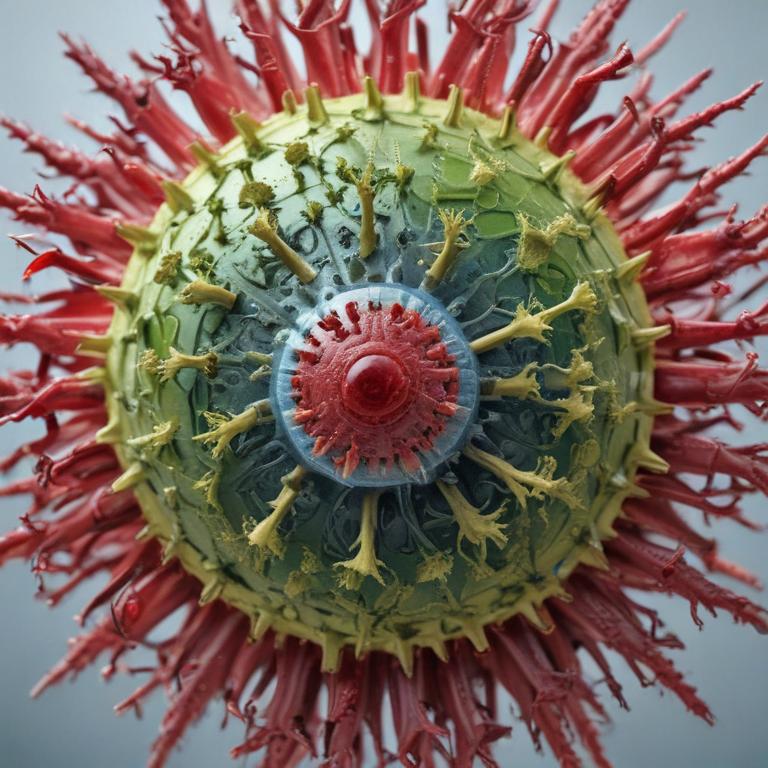发音 (Pronunciation):
IPA: /ˈvaɪrəs/
中文近似: '维勒斯'
中文意思与词性 (Meanings & Part of Speech):
- 病毒 (n.)
- 毒素 (信息待补充)
例句 (Examples):
1. The virus spread rapidly among the population.
(病毒在群体中迅速传播。)
2. Scientists are studying the virus to develop a vaccine.
(科学家正在研究这种病毒以开发疫苗。)
用法提示 (Usage Tip):
注意区分 'virus' 和 'bacteria',前者是病毒,后者是细菌。
更多关于 "virus" (More about "virus")
单词来源 (Etymology)
该词源于拉丁语 'virus',原意是“毒液”或“毒素”。
词根词缀解析 (Root & Affix Analysis)
该词为基础词,未包含复杂的词根或词缀。
“virus”的字母与词根个性化解读
字母象形/引申义 (个性化参考)
- 字母 'v' 的象形或引申含义可能包括: 山谷 -> 风口 -> 路 -> 往返/走 (via, vent); 牛角 -> 牛 -> 强壮征服 -> 能力价值 (val, vinc); 转和活 (vol同源); 手 (V=F); 音变: V=U=W; V=B=P=M=F。
- 字母 'i' 的象形或引申含义可能包括: 我 (an, any, one -> 人); 水滴 -> 水 (ice); 尖, 一点, 小 (inch); 元音互换: A=E=I=O=U=W=Y。
- 字母 'r' 的象形或引申含义可能包括: 直立, 向上 (字母R形); 走, 跑 (R象形人); 弯曲 (舌头卷曲); 音变: R=L=M=N。
- 字母 'u' 的象形或引申含义可能包括: 中空 -> 容器 -> 用具 -> 使用; 音变: U=V=W; U=A=E=I=O=Y。
- 字母 's' 的象形或引申含义可能包括: 水波纹/走路痕迹 (S象形); 吐气轻细咝 -> 说话 (拟声); 音变: S=C=Z=TH=X。
学习提示:以上针对单词 virus 的字母和词根解读,主要基于提供的特定象形及词根资料。这些提示旨在启发联想,而非绝对定论。更通用的记忆规则和原则请参考首页。英语词源复杂多变,实际应用中请结合更全面的词源词典和语言学知识进行深入学习。
常用词组 (Common Phrases)
- computer virus: 计算机病毒
- viral infection: 病毒感染
其他语言 (Other Languages)
- 德语: Virus
- 法语: virus
字母整体创意联想
单词 'virus' 可以想象成一个小生物在移动,'v'像一只翅膀,'irus'像身体。
逐字母创意解读
中文谐音助记
“维他命” -> “维持生命的毒”
相关电影/名言
"The virus is out there, and it's spreading."
(病毒在外面,正在传播。)
- 《传染病》(2011)
趣味知识/故事
病毒不仅在医学上有重要意义,在计算机科学中也有类似的概念,计算机病毒指的是能够自我复制并传播至其他计算机的恶意软件。
拓展信息
病毒是一种微小的感染性病原体,不能独立生存,必须依赖宿主细胞进行繁殖。
在医学领域,病毒引起多种疾病,从普通感冒到艾滋病。
此外,病毒也被广泛应用于基因工程和疫苗开发中。
网络参考 (More about "virus" from the Web)
Virus - Wikipedia
A virus is a submicroscopic infectious agent that replicates only inside the living cells of an organism. [1] Viruses infect all life forms, from animals and plants to microorganisms, including bacteria and archaea. [2] [3] Viruses are found in almost every ecosystem on Earth and are the most numerous type of biological entity.
Virus | Definition, Structure, & Facts | Britannica
virus, infectious agent of small size and simple composition that can multiply only in living cells of animals, plants, or bacteria.The name is from a Latin word meaning "slimy liquid" or "poison.". The earliest indications of the biological nature of viruses came from studies in 1892 by the Russian scientist Dmitry I. Ivanovsky and in 1898 by the Dutch scientist Martinus W. Beijerinck.
Viruses: Definition, Types, Characteristics & Facts - Cleveland Clinic
Learn what viruses are, how they infect hosts and cause diseases, and what types of viruses exist. Find out how viruses reproduce, how they are classified and how they can be treated.
更多图片 (virus More Images)

